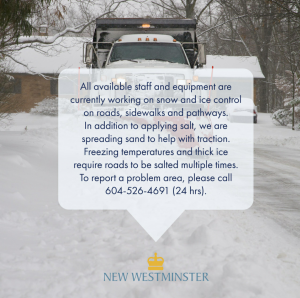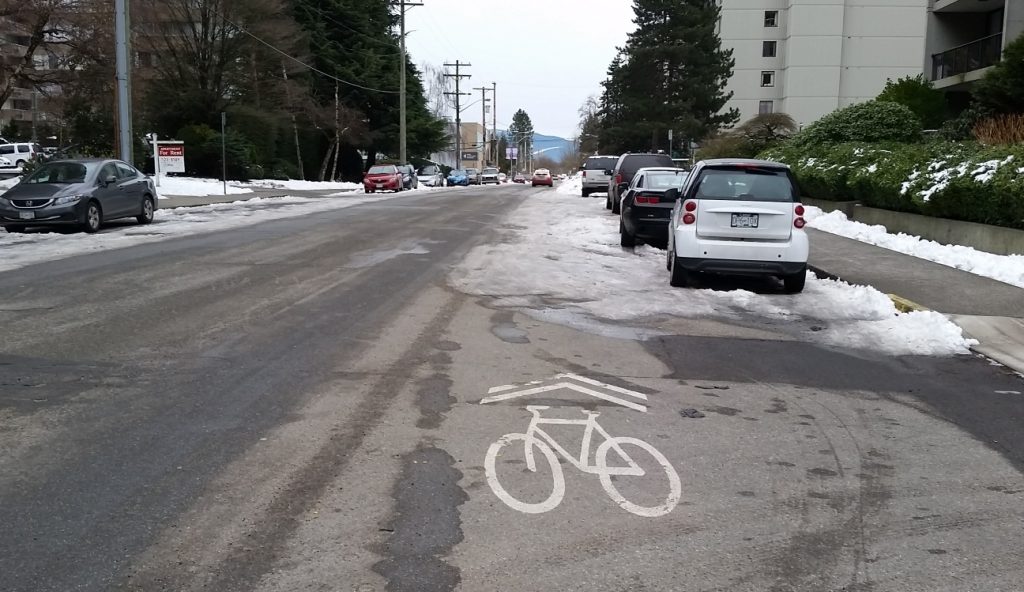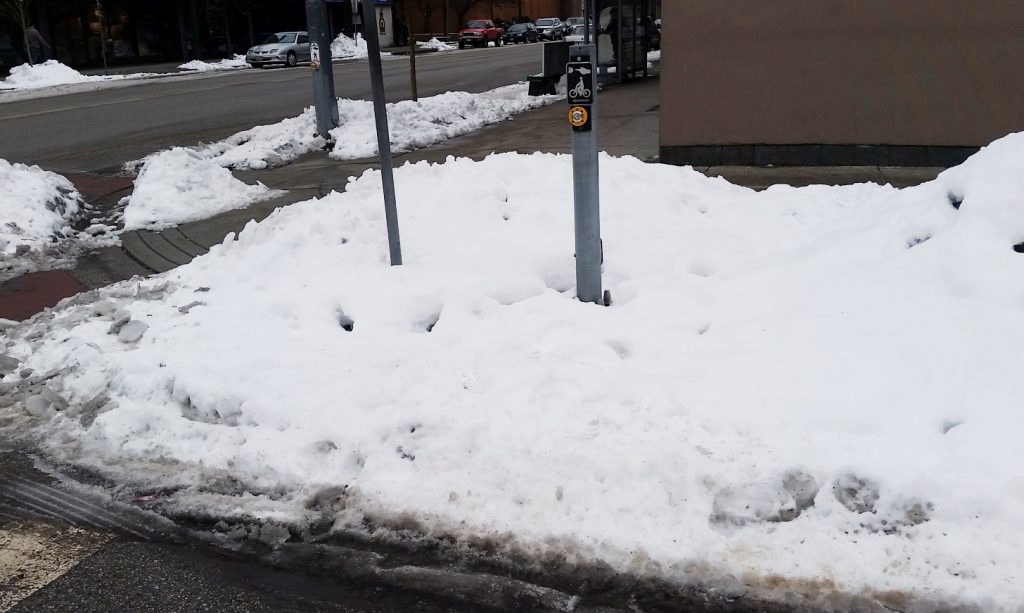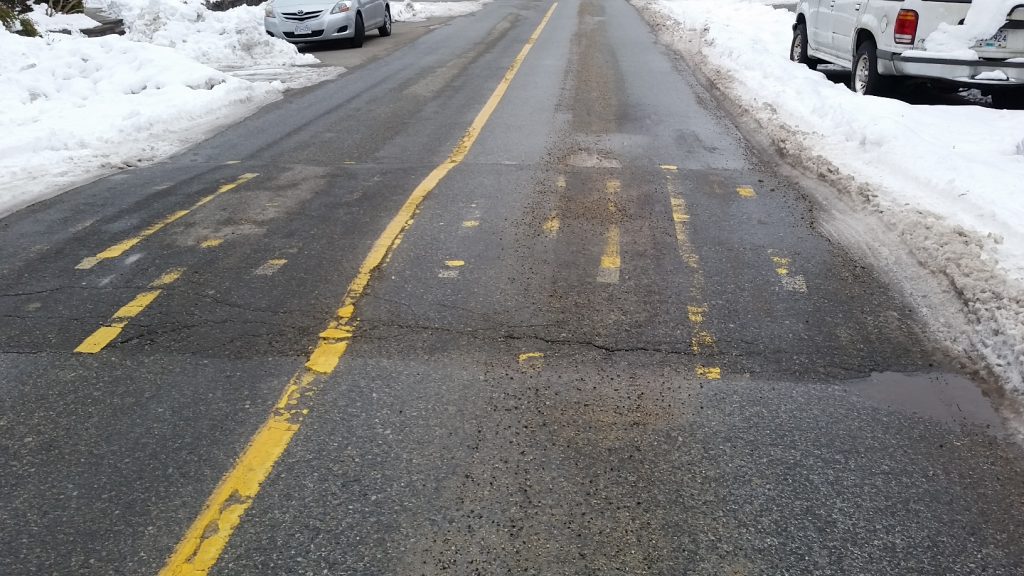I’m back from vacation, ~three weeks in a place far away from the snow. It started snowing here a week before I left, so I was fully expecting it to be long gone by my return – how often does snow stay on the ground for more than a few days in New West?
While I was sweating in tropical heat, my occasional checks with social media back home kept telling me the snow wasn’t stopping. Or if it did stop, it did so just long enough for the ice to harden up and make the next layer of snow more treacherous. From afar, it appeared there was a constant deterioration of conditions for drivers and pedestrians over the last three weeks.
Sure enough, criticisms of the situation became a theme in Facebook. People should shovel sooner, no salt or shovels are available anywhere, Translink schedules are useless, drivers need to slow down and buy snow tires, the City hasn’t done enough to make roads/sidewalks/sidewalks. On other social media (especially Instagram) I read more understanding of the conditions, encouragement to help your neighbour, and pics of once-in-a-lifetime sledding adventures. Something about Facebook…
It is worth noting this started with a pretty significant forecast failure. The first snow was on December 5, which was forecast to be morning flurries shifting to rain by noon, then a temperature drop in the evening. Instead, the snow started early in the morning and didn’t stop for 6 hours. I remember it well, as I did a quick light walk shovel before Council, then had to shovel again much more when I got home at 10 at night. A bit of an inconvenience, but nothing unusual for my 50 feet of sidewalk. By the next morning, I was already back out chipping ice. Something about the weather cycle led to really quick ice accumulation.
For City crews, this type of forecast miss is a much larger problem, because it requires an unexpected and complete change in approach. If Environment Canada tells you it is going to rain hard for 6 hours, there is no point going out and applying deicing, as it will be washed away before it can be effective. At some point, once the forecast proves to be going wrong, you need to re-equip and change approach, which costs you manhours, and impacts response time. You are already behind, and you haven’t even started.
In short, managing snow removal on a city-wide scale is a technical challenge, and for a City like New Westminster, where we usually only get one dusting a year, it is an equipment challenge. This is another good time to point out that New Westminster has the highest percentage of its land base covered by roads of any City in British Columbia, and an unusual amount of those roads are on steep hills. We are prepared to deal with a “typical” snow situation, and with situations like freezing rain forecasts, but a solid three weeks of new snow, partial melt, re-freeze, new snow, repeat, clearly challenges our resources.
And despite the prevailing narrative on Facebook, New West turned out to be doing a pretty good job compared to most other Lower Mainland communities dealing with the issue. Our works crews are out there, clearing priority routes, dealing with complaints as best they can, and prioritizing their resources with public safety their top priority. They were busting double shifts while I was on a beach in Sri Lanka and many others were warming their toes by the fire with their family. So if you have a chance to thank a Muni worker today, please do so!

That’s not to say everything is perfect in New West, and now a good 4 weeks in, there are still some sub-optimal conditions out there, especially for pedestrians. This is understandable for a few days in a snow emergency, but for it to go on for a month is a real hardship for many people. I cannot imagine how difficult it would be to have a serious mobility issue right now, and to have spent the last 4 weeks struggling to get around town and even do basic shopping tasks.
So what can we do better?
I’m sure there will be a discussion at Council about this on Monday, and I expect we will ask Staff to report about successes, issues, and failures. We can discuss the budget implications of any expanded response, and I want to put that in context right up front: You may not notice (say) a half-million dollars in expanded snow removal and ice management. Salt is expensive when you buy it by the tonne, especially in times of shortage. The trucks that distribute it are expensive, as is specialty equipment to clean sidewalks or park paths. By the nature of the unexpected timing of response, much of the work is overtime, at night, and on holidays. I’m generally curmudgeonly, but not such a Scrooge that I don’t think workers deserve more pay when they are taken away from their families at Christmas. You will, however, notice that half million dollars as a .8% tax increase. There is no cost recovery on snow removal, and fining people for not shoveling their walks will not come close to providing that kind of revenue.
So I think a more important discussion to have is how to prioritize the resources we have (or expanded resources we need), and how to best address each priority?
Fundamentally, we are talking transportation here, so the City’s Master Transportation Plan should be the basis for setting priorities. There is no clearer demonstration or the declared priorities than this one on Page 48:

Pedestrians (including those with mobility impairments) > cyclists > transit users > private vehicles. How do we address each of these?
Pedestrians: Short version, many are not feeling like they are top priority right now. Roads are cleared by a variety of City equipment by City crews working through the night when necessary, all at taxpayers expense (interesting side-point, I’ll have to check if we get extra money from TransLink for snow maintenance on MRN routes). For sidewalks, we rely on residents, businesses, and other building owners to clean the sidewalks adjacent to their property, with predictably unreliable results. I don’t know how to spin that into making it sound like pedestrians are a priority.
This system is not unusual in the Lower Mainland. Almost every municipality has a similar clear-your-own-sidewalk Bylaw (Richmond a notable exception). It is probably obvious why this approach is taken – we have 250+ kilometers of sidewalks, and employing enough people to clear them all in any kind of reasonable time (say, before summer starts) would be prohibitively expensive. If you can get 30,000 property owners to do a little bit each, well, many hands make light work.
Of course, this system only works if those “volunteers” actually do the work. Unfortunately it takes a depressingly small amount of non-compliance to make sidewalks less safe, especially for vulnerable users, and we have more than just a small amount of non-compliance. Which bring us to the topic of Bylaw enforcement.
I feel the need to repeat this so Facebook can hear: we cannot pay for snow clearing with fines. It costs a City a lot of money to issue and enforce a ticket, and fines (ours are $80, less if you pay sooner, more if you default) barely cover that cost. The idea that someone can just drive around in a car, snap a photo, and send a ticket in the mail is fanciful. Our justice system and the Local Government Act are just not structured to allow that (probably for good reason – you probably don’t want your local government given this power).
However, I think we can do a better job using Community Based Social Marketing techniques. There is a basic understanding that for social initiatives such as shoveling the public space near your home, some people (~10%) will do it automatically out of an abundance of civic duty, most (~80%) will do it if they are properly educated about the benefits and feel social pressure from their neighbours, and some (~10%) need to be threatened into doing something by Bylaw enforcement. I would suggest our non-compliance rate indicates more education and social pressure is needed before we ramp up Bylaws.
There is another aspect to this issue when we rely on public participation, and that is the unpredictability of snow itself. People need to prepare ahead of time, and once the situation hits, shovels and salt are invariably sold out. People, in general, are terrible planners (see comments below about snow tires). I don’t know how to address that, as in a situation like this year, even the City ran into resourcing issues.
A bigger problem is the parts of the pedestrian realm that aren’t clearly covered by the Bylaw. I snapped a couple of photos while riding my bike to a meeting today:


Who is responsible for these spaces? I’m not sure the Bylaw is clear, and unfortunately, these are important links in our pedestrian network that make sidewalks inaccessible for many people. We need to address this gap.
Cyclists: As a cyclist and someone who commutes by bike regularly, I know protracted snow is about the worst thing for cycling access. Snow is often plowed off of the driving lane and accumulates in the shoulder. Our cycling infrastructure is such that transitions from road to bike path or shared path and back are a constant part of any trip, and those transitions are where snow accumulates. The “narrowing” of roads by accumulated snow means bikes are forced to “share the lane” in a way that, although perfectly legal, frustrates drivers and makes cyclists feel less safe. Add to this that ice that may make a car slip a little will make someone on two wheels immediately fall down.

Aside from assuring greenways or designated bike routes are cleared curb-to-curb, and perhaps requiring the removal of parked cars from greenways during snow events in order to facilitate this, I’m not sure what we can do to make cycling safer in these conditions, “Fat Bikes” and studded tires aside.

Transit: This follows on pedestrian access a bit. I think it is obvious that transit routes should be top priority for road clearing and de-icing. However, without curb-side clearing, access to busses is seriously impaired. Currently, our Bylaw treats bus pads like sidewalks – the adjacent property owner is responsible for keeping them clear. To me, this is a recipe for problems, and is something I think we need to address. I think bus pads and adjacent curb areas are a place where City Crews need to be assigned to do the cleaning. Transit should be the safe, accessible option for people in the lower mainland unsure about driving in the snow. We need to step up and make it accessible.

Drivers: What can I say? I grew up in the Kootenays, so I hold a smug opinion about my ability to drive in the snow. Mostly, though, I just avoid driving in terrible conditions, and looking around the lower mainland, mostly wish others would exercise such restraint. It’s crazy out there: Our cities are not equipped to deal quickly with deteriorating conditions, a huge number of drivers have *no idea* what they are doing, and few have the tires or other equipment to handle frosty conditions.
But people have to drive, I get it. Some are limited in other options, some have businesses to run and responsibilities to be met. If that is your case – for the love of Chione – get yourself some proper tires and slow the hell down.

From a City point of view, we handle the car part pretty well. We concentrate on major routes, and especially on important and dangerous intersections. The situation with ice this year was really hard to manage as far as removal: it is neigh impossible to remove packed ice without tearing up the underlying asphalt, which is really expensive to replace. The increased number of speed bumps on secondary roads (see above) are quickly damaged by even the most gentle plow technique. At this point, sand is our best friend, as anyone who has lived in Montreal or similar ice-bound cities will recognize.
If we are going to vary from the MTP priorities, it needs to be for good public safety and risk management reasons. Access to RCH for ambulances, access on priority routes for fire trucks and other first responders, and assuring high-risk intersections (Sixth Street at Royal is the first example that comes to my mind) are safe or closed should be high on the list. Fire Hydrants need to be cleared so they are accessible. One could further argue vulnerable populations (pathways around schools, seniors homes, etc.) could get bumped up priority-wise, as may access to the Works Yard (so people working to remove snow and ice can get to and from work) .
There is another issue we have not yet covered: what happens when all of this melts? If we get hit by a Pineapple Express next week, then we may have a dreaded “rain on snow event” – a condition where local flooding is likely. Where do we prioritize assuring catch basins and drainage infrastructure are cleared and functioning optimally? Are there locations (like the Works Yard) where snow is accumulating that are likely to flood if a significant rain event occurs?
I am raising more questions than I am answering, because I recognize my lack of expertise in this. I’m just an elected guy, whose job it is to relate public expectations into performance on the ground. There are crews at our yard with decades of experience at this, who no doubt have clear ideas how to get these priorities done. I assume most of them are not on Facebook. All we can do as a Council is give them clear guidance on priorities, and give them the tools they need to do the job. Operationally, they are the experts. And frankly, I am looking for ideas. How can we do this better?
In many ways, the logistical challenges of New Westminster road management (lots of roads and through-traffic, steep hills, lots of pedestrians, smaller city budget- and equipment-wise) are similar to North Vancouver City. We are more inland (and get more snow all around), but they go up higher (so probably have more persistent snow). I am hoping to do a bit of comparison/contrast with them in coming weeks. Vancouver is very different beast, because of sheer scale (however it has been funny to hear half of Vancouver complain that the bike routes are impassable, while the other half complain that the roads are impassible because bike paths were cleared first – which makes it no different than any other Vancouver issue!)
There is much to learn here, and I am happy to hear your constructive suggestions. Tune into Council tomorrow, as we are likely to have a discussion on this topic later in the meeting. And let’s all try to help each other a little out there. Let’s be more Instagram, less Facebook.